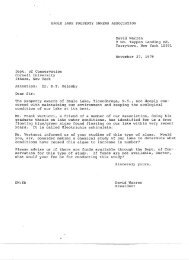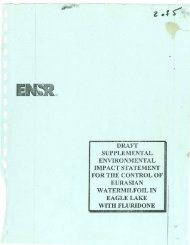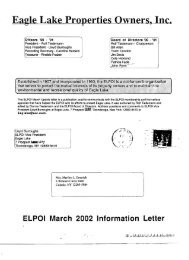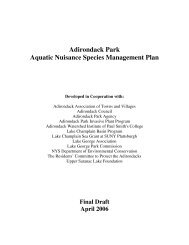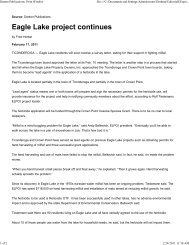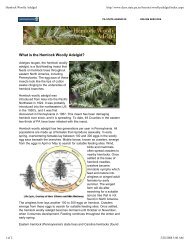Maine Field Guide to Invasive Aquatic Plants - Brant Lake Milfoil ...
Maine Field Guide to Invasive Aquatic Plants - Brant Lake Milfoil ...
Maine Field Guide to Invasive Aquatic Plants - Brant Lake Milfoil ...
Create successful ePaper yourself
Turn your PDF publications into a flip-book with our unique Google optimized e-Paper software.
INVASIVE VARIABLE WATER-MILFOIL HYBRID<br />
Myriophyllum heterophyllum X Myriophyllum laxum<br />
NOT NATIVE TO MAINE - INVASIVE<br />
I N V A S I V E P L A N T S<br />
NOTE: All leafy milfoils display a wide range of vegetative<br />
variability. Any milfoil found in <strong>Maine</strong> waters should be considered<br />
“suspicious” until a positive identification has been confirmed by<br />
someone with the appropriate expertise.<br />
The invasive variable water-milfoil hybrid is not explicitly prohibited<br />
by <strong>Maine</strong> law. However, the hybrid is half variable water-milfoil<br />
and, as such, is treated as a prohibited invasive plant by The <strong>Maine</strong><br />
Department of Environmental Protection.<br />
Habitat: The invasive water-milfoil hybrid is an extremely well<br />
adapted plant, able <strong>to</strong> thrive in a wide variety of environmental<br />
conditions. It grows well in still and flowing waters, and can survive<br />
under ice. The hybrid grows rooted in water depths from 1 <strong>to</strong> 5<br />
meters on various substrates including organic muck, silt, sand<br />
and gravel.<br />
Description: This hybrid milfoil is a cross between variable watermilfoil<br />
(M. heterophyllum) and loose water-milfoil (M. laxum), a<br />
milfoil native <strong>to</strong> the southeastern United States. The hybrid is a<br />
submersed, aquatic plant with branching stems emerging from<br />
dense, spreading roots. Feather-divided leaves are arranged in<br />
densely packed whorls. (Some of the leaves in the whorl may be<br />
slightly offset.) There are generally 4 <strong>to</strong> 6 leaves per whorl and<br />
5 <strong>to</strong> 14 pairs of thread-like leaflets on each leaf. The dense leaf<br />
arrangement give this plant a bottle brush appearance. Stems are<br />
typically reddish in color (even bright red). Leaves may also be red.<br />
Flowers occur on emergent spikes.<br />
Two features (both present on the emergent flower spike) distinguish<br />
the hybrid from its invasive parent, variable water-milfoil<br />
(M. heterophyllum): 1) The bracts and flowers of the hybrid are<br />
arranged both alternately and whorled, as opposed <strong>to</strong> the strictly<br />
whorled arrangement found on the flower spikes of M. heterophyllum.<br />
2) The bracts of the hybrid range from pinnately lobed, <strong>to</strong><br />
elongate and entire. (Bracts on M. heterophyllum are mostly serrated<br />
and blade-shaped.)<br />
The hybrid does not produce winter buds; M. heterophyllum does.<br />
32 <strong>Maine</strong> Volunteer <strong>Lake</strong> Moni<strong>to</strong>ring Program



